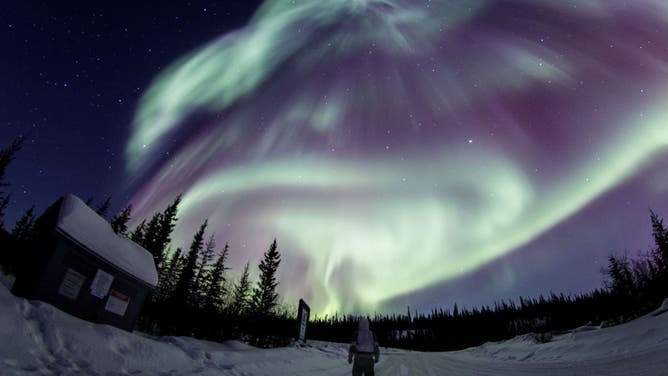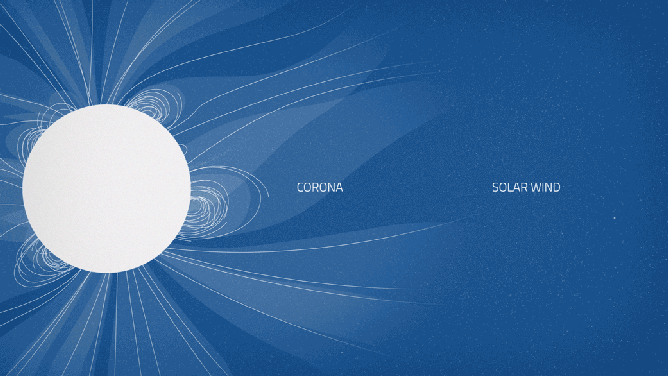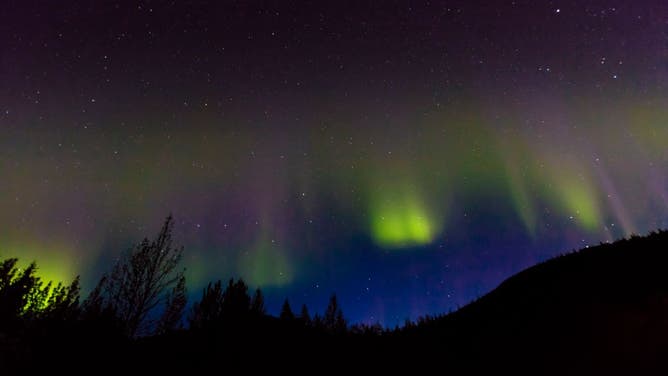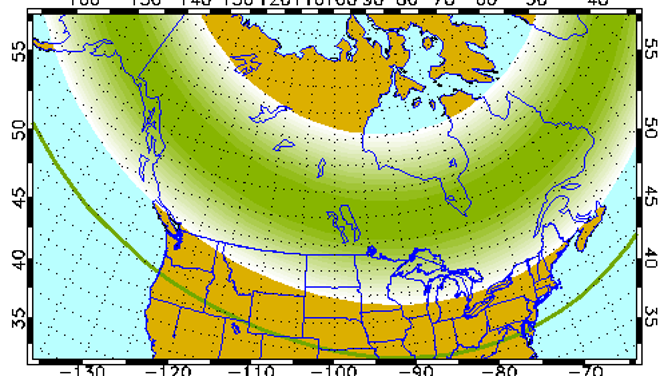Solar storm increases chance of aurora views for northern US
Space Weather Prediction Center issues moderate geomagnetic storm watch for Oct. 11-12

View of aurora borealis storm during midnight in Yellowknife. (Photo by Dominic Chiu/SOPA Images/LightRocket via Getty Images)
(Getty Images)
A geomagnetic storm caused by solar flare is bringing the possibility of technical disruptions over the next two days, but it will also bring some beautiful aurora views for areas of the U.S. that don't usually experience the lights.
The Space Weather Prediction Center with NOAA issued a geomagnetic storm watch for Monday and Tuesday. Space weather events happen when the sun emits a coronal mass ejection or solar flare, hitting Earth's atmosphere.
According to the SWPC, this is a G2 event, or moderate. The Geomagnetic weather scale starts with G1, with G5 being the most severe. Geomagnetic weather can disrupt GPS satellites and radio depending on the severity of the solar storm.
The SWPC models suggest the solar flare will blast into Earth's atmosphere Monday around midday with lingering impacts into Tuesday.
Forecasting space weather
Don Hampton is a researcher with the University of Alaska Fairbanks Geophysical Institute specializing in atmospheric and space sciences. Fairbanks is one of the best places in the U.S. to witness auroras produced by the solar wind.
"Almost any night, if it's clear, even if you have to look off to the north, you'll be able to see some little activity," he said, adding about half the time the lights appear over their heads directly.
There are several stages to predict incoming solar flares, explains Hampton, using ground-based observations and satellites.
"Once they see what's called a coronal mass ejection, or the solar wind, coming off of the Sun, you get two or three days of advance warning," Hampton said.
This is what the SWPC geomagnetic storm was issued from, according to Hampton.
The time from when a CME is spotted to when it reaches Earth is quick, considering the sun is over 92 million miles away.
"Just like the steam off the top of a cup of tea, there's always some particles coming off, and they come off, and they're moving pretty fast," Hampton said, adding those particles are moving at 400 kilometers per second and takes about three days to reach Earth.
Potential impacts from solar wind to life on Earth

This NASA graphic shows when corona becomes solar wind, which eventually reaches Earth.
(NASA)
Possible effects from the solar event include power grid fulgurations, voltage alarms at higher latitudes. For satellites, it could have orientation irregularities and increased drag on satellites in low-Earth orbit.
Due to the flare, there is a slight chance for minor to moderate radio blackouts from Tuesday to Wednesday.
Solar storms rarely cause major outages and damage, but historically, some space weather events cause communication issues and extremely bright aurora lights.
The most famous solar flare is known as the Carrington Event of 1859. According to NASA, the 1859 event was powerful enough to produce auroras of red, green, and purple as bright as daylight even in tropical latitudes over Cuba and the Bahamas. The solar storm caused telegraph systems worldwide to go berserk.
Another event in 1972 knocked out telephone lines, prompting AT&T to redesign its power grid system, according to NASA.
Neon lights in the sky: What makes the colors glow

Aurora Borealis or Northern Lights illuminate the night sky from Kantishna, Alaska, Mnt. Denali National Park. (Photo by: Joe Sohm/Visions of America/Universal Images Group via Getty Images)
(Getty Images)
On Monday and Tuesday, aurora lights may be visible to parts of the lower 48, including as low as New York to Wisconsin, across to Washington State.
Glowing Aurora lights happen when electrically charged particles from the sun crash into Earth's atmosphere. There are always auroras around the magnetic poles of the northern and southern hemispheres, but sometimes with the help of a strong solar storm, more areas can also witness the lights.
Hampton explained that the bright greens, blues, and purples of the lights are similar to a neon sign.
"Its electrons moving at pretty high speeds, they bump into atoms and molecules in our upper atmosphere that dumps little energy into those atoms and molecules, and then they relax back down to the ground state," Hampton said. "And when they do that, they release a little bit of light."
Those atoms and molecules have specific energies and they can only produce certain colors of light.
According to the University of Alaska Fairbanks, aurora activity will be high Monday and Tuesday based on the Kp Index, which rates the severity of magnetic disturbances. The scale goes from 0, very quiet, to 9, being the most disturbed.
Monday's aurora forecast indicates this event will be a six on the Kp Index, meaning there is a good chance for some colorful activity if the sky is clear.
"People in the northern tier states, say Minnesota or North Dakota, or along the northern border may well see some glow in the sky off to the north, or maybe even closer to overhead," Hampton said.
In the lower 48? ‘Drive north’ to see the lights

University of Alaska Fairbanks aurora forecast for Oct. 11, 2021. A solar storm will produce powerful lights even as far south as New York.
(University of Alaska)
Aurora lights are best viewed away from city lights; the darker the area, the better. Some in the forecasted viewing areas Monday night might have a hard time due to the weather.
KMSP FOX 9 Minneapolis Chief Meteorologist Ian Leonard said, unfortunately, Minneapolis-St. Paul residents "don't have a hope" of seeing the lights this week because of an area of low pressure dragging across the Candian border.
With 3.5 million residents in the area, the light pollution is extreme. Anyone who wants to see the aurora without the cloud cover will need to get outside of any populated area.
"We tell everybody and go as far as you can and get away from the city," Leonard said, adding he usually drives an hour north with his family when there is an excellent opportunity to view aurora lights.
Still, Leonard said if you ever get the chance and the sky is clear, everyone should try to see the "psychedelic dance" of the northern lights.
"They probably are the top three weather thing you'll see in your life," Leonard said.
Meanwhile, in Seattle, the weather is primarily clear through 2 a.m. Portland and Salem, Oregon are both mainly expecting clear nights.
Hampton was hooked after seeing his very first aurora more than 30 years ago.
"I don't think you get the immensity of it by even looking at a picture," he said. "You can put a nice wide-angle or timelapse up there, but you just don't get the idea how this immense it is."
And even after decades of studying the colorful reaction between Earth and space, Hampton said that wonder never goes away.
"Honestly, the more you know about it doesn't reduce your interest in it," he said. "I think it just makes it more interesting. Why? Why is it doing that? How does it do that?"